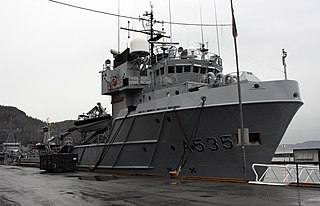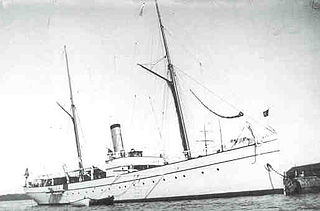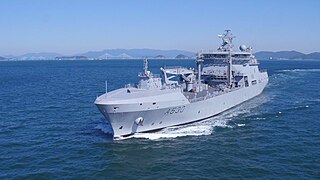
The Royal Norwegian Navy is the branch of the Norwegian Armed Forces responsible for naval operations of Norway. As of 2008, the Royal Norwegian Navy consists of approximately 3,700 personnel and 70 vessels, including 4 heavy frigates, 6 submarines, 14 patrol boats, 4 minesweepers, 4 minehunters, 1 mine detection vessel, 4 support vessels and 2 training vessels. It also includes the Coast Guard.

The Oslo-class frigate is a Royal Norwegian Navy frigate design, based on the US Navy Dealey-class destroyer escorts. The forward hull was customized to suit Norwegian sea conditions better and several sub-systems were European built.

The Hauk-class patrol boats were a series of Norwegian fast attack craft. Hauk means hawk in Norwegian. They were ordered in the 1970s and the first boat, Hauk, was commissioned on 17 August 1977. Designed as a development of the Storm and Snøgg classes, by Lieutenant commander Harald Henriksen, the 14 Hauk-class vessels made up the Coastal Combat Flotilla, responsible for protecting the rugged coastline of Norway. The ships were modernized frequently and in their later form were known as "Super-Hauks." The Royal Norwegian Navy deployed four of these warships for anti-terror patrol in the Strait of Gibraltar.

A submarine chaser or subchaser is a small naval vessel that is specifically intended for anti-submarine warfare. Many of the American submarine chasers used in World War I found their way to Allied nations by way of Lend-Lease in World War II.

HNoMS Valkyrien has the pennant number A535 and is the present support vessel for the Royal Norwegian Navy Coastal Combat Flotilla. Valkyrien was built as a civilian supply vessel in 1981. She was bought by the RNoN in 1994. Command was assumed on 4 February 1994. The ship has a strengthened hull and meets the requirements of ice breaking class ICE C. The vessel has a displacement of 3,000 tons and a top speed of 16.5 knots (30.6 km/h). The ship also had towing and anchor handling capacities. As a civilian ship she had a crew of 11. Today she has a crew of about 20-25.
HMS P41 was a Royal Navy U-class submarine built by Vickers-Armstrong. She was transferred to the exiled Royal Norwegian Navy before completion and renamed HNoMS Uredd. She and one of the B-class in 1940 have so far been the only Norwegian submarines to have been sunk.

The Norwegian Coast Guard is a maritime military force which is part of the Royal Norwegian Navy. The coast guard's responsibility are for fisheries inspection, customs enforcement, border control, law enforcement, shipping inspection, environmental protection, and search and rescue. It operates throughout Norway's 2,385,178-square-kilometer (920,922 sq mi) exclusive economic zone (EEZ), internal waters and territorial waters. It is headquartered at Sortland Naval Base. In 2013 the Coast Guard had 370 employees, including conscripts, and a budget of 1.0 billion Norwegian krone.

The Nornen-class patrol vessel is a Norwegian inshore patrol vessel designed for coast guard duties such as search and rescue, fire fighting, environmental protection, customs duties and police duties.

Leif Welding-Olsen was the commander of the Royal Norwegian Navy patrol boat HNoMS Pol III. He was the first Norwegian to be killed during the German invasion of Norway. On 8 April 1940, Leif Welding-Olsen raised the alarm as the German navy ships moved past the guard lines in outer Oslofjord. Norway had been attacked at 2205hrs that evening as German ships passed the Norwegian territorial borders. Captain Welding-Olsen had a brief conversation with the commander of one of the German torpedo boats, who demanded that he surrender, but Welding-Olsen refused. Realizing that the enemy would not turn away, and was going to violate Norwegian neutrality, Pol III fired flares to alert Norwegian coastal batteries and rammed the Albatros.
The Snøgg class was a Royal Norwegian Navy class of fast patrol boats (FPB). It might also be classified as a torpedo boat or a missile boat. In Norway this type of vessel is called a missile torpedo boat (MTB). The class was named after its lead vessel, Snøgg, which is a Norwegian word meaning "fast". All of the subsequent names are synonyms of "fast".

The minelayer HNoMS Olav Tryggvason was built by the naval shipyard at Horten in the early 1930s and had build number 119. She served in the Royal Norwegian Navy until captured by the Germans in 1940. The Germans renamed her first Albatros II, and a few days later Brummer. She was wrecked in a British bombing raid in northern Germany in April 1945.

HNoMS Rauma was an Otra-class minesweeper built in 1939 for the Royal Norwegian Navy. Captured by the Germans during the 1940 invasion of Norway and renamed Kamerun, she was returned to the Norwegians after the end of the Second World War and recommissioned in 1947. Rauma remained in service until being sold for scrapping in 1963.

HNoMS Heimdal was a Norwegian warship built at Akers mekaniske verksted in Kristiania, Norway in 1892 with build number 137.

HNoMS Ula, previously HMS Varne, a British-built U-class submarine, and a member of the third group of that class to be built. She never actually served under the name Varne, being transferred before commissioning to the exiled Royal Norwegian Navy as HNoMS Ula (S300). In 1944 she sank a German U-boat during one of her patrols off Norway. She remained in Norwegian service and was scrapped in 1965.

HNoMS Horten (A530) was a Norwegian support vessel built at Karljohansvern in Horten, the city from which the ship was named, in 1977. She was in service with the Royal Norwegian Navy until her retirement in 2008 and filled a number of roles while in service.

The Tide-class tanker is a class of four fast fleet tankers that entered service with the British Royal Fleet Auxiliary from 2017. The 37,000 t ships provide fuel, food, fresh water, ammunition and other supplies to Royal Navy vessels around the world. Norway ordered a similar 26,000 t version with a 48-bed hospital and greater solid stores capacity, but reduced liquid capacity; it was delivered in November 2018 as HNoMS Maud two years after originally planned. The two classes are very similar, but are not directly comparable due to large variance in capabilities delivered.
Allied Forces South Norway (SONOR) was a NATO command tasked with the defense of Southern Norway. SONOR's area of responsibility included all of Norway with the adjacent sea territory excluding the three northernmost counties of Norway, which were under Allied Forces North Norway.

HNoMS Maud is a replenishment oiler constructed at Daewoo Shipbuilding & Marine Engineering in South Korea. She was built on behalf of the Norwegian Defense Materials Agency Forsvarsmateriell, for service in the Royal Norwegian Navy.















